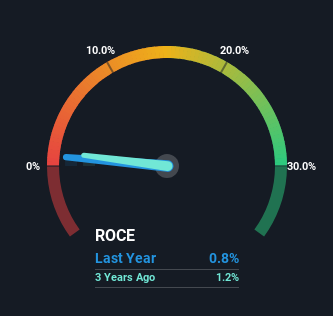- Australia
- /
- Professional Services
- /
- ASX:CUP
Investors Could Be Concerned With Count's (ASX:CUP) Returns On Capital
If you're not sure where to start when looking for the next multi-bagger, there are a few key trends you should keep an eye out for. In a perfect world, we'd like to see a company investing more capital into its business and ideally the returns earned from that capital are also increasing. This shows us that it's a compounding machine, able to continually reinvest its earnings back into the business and generate higher returns. However, after briefly looking over the numbers, we don't think Count (ASX:CUP) has the makings of a multi-bagger going forward, but let's have a look at why that may be.
Understanding Return On Capital Employed (ROCE)
Just to clarify if you're unsure, ROCE is a metric for evaluating how much pre-tax income (in percentage terms) a company earns on the capital invested in its business. Analysts use this formula to calculate it for Count:
Return on Capital Employed = Earnings Before Interest and Tax (EBIT) ÷ (Total Assets - Current Liabilities)
0.0083 = AU$1.2m ÷ (AU$440m - AU$293m) (Based on the trailing twelve months to December 2022).
Therefore, Count has an ROCE of 0.8%. In absolute terms, that's a low return and it also under-performs the Professional Services industry average of 13%.
View our latest analysis for Count

In the above chart we have measured Count's prior ROCE against its prior performance, but the future is arguably more important. If you're interested, you can view the analysts predictions in our free report on analyst forecasts for the company.
What The Trend Of ROCE Can Tell Us
In terms of Count's historical ROCE movements, the trend isn't fantastic. Over the last five years, returns on capital have decreased to 0.8% from 6.5% five years ago. However, given capital employed and revenue have both increased it appears that the business is currently pursuing growth, at the consequence of short term returns. If these investments prove successful, this can bode very well for long term stock performance.
While on the subject, we noticed that the ratio of current liabilities to total assets has risen to 67%, which has impacted the ROCE. Without this increase, it's likely that ROCE would be even lower than 0.8%. What this means is that in reality, a rather large portion of the business is being funded by the likes of the company's suppliers or short-term creditors, which can bring some risks of its own.
The Bottom Line
In summary, despite lower returns in the short term, we're encouraged to see that Count is reinvesting for growth and has higher sales as a result. These trends are starting to be recognized by investors since the stock has delivered a 7.6% gain to shareholders who've held over the last five years. Therefore we'd recommend looking further into this stock to confirm if it has the makings of a good investment.
Count does have some risks, we noticed 4 warning signs (and 1 which shouldn't be ignored) we think you should know about.
While Count may not currently earn the highest returns, we've compiled a list of companies that currently earn more than 25% return on equity. Check out this free list here.
New: AI Stock Screener & Alerts
Our new AI Stock Screener scans the market every day to uncover opportunities.
• Dividend Powerhouses (3%+ Yield)
• Undervalued Small Caps with Insider Buying
• High growth Tech and AI Companies
Or build your own from over 50 metrics.
Have feedback on this article? Concerned about the content? Get in touch with us directly. Alternatively, email editorial-team (at) simplywallst.com.
This article by Simply Wall St is general in nature. We provide commentary based on historical data and analyst forecasts only using an unbiased methodology and our articles are not intended to be financial advice. It does not constitute a recommendation to buy or sell any stock, and does not take account of your objectives, or your financial situation. We aim to bring you long-term focused analysis driven by fundamental data. Note that our analysis may not factor in the latest price-sensitive company announcements or qualitative material. Simply Wall St has no position in any stocks mentioned.
About ASX:CUP
Count
Provides accounting, business advisory, and financial planning services in Australia.
Undervalued with reasonable growth potential.
Market Insights
Community Narratives




